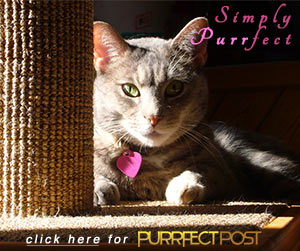Vomiting in Cats

You’re relaxing on the couch when you hear that familiar retching noise: “Huk, huk, huk…” Part of you hopes that whatever Cleo is bringing up will land on the tile floor rather than the rug, but you also feel that niggling worry; is she okay? Most people who live with cats have some experience with cleaning up vomit, but what when is there cause for concern? And if Cleo has to see the veterinarian, what sort of information would be helpful to have, and what testing may be performed?
Should My Vomiting Cat Go to the Veterinarian?
Your cat may vomit once or twice but then seem just fine, with normal behavior, energy, and appetite. The vomiting may be self-limiting and respond to home treatment (see box below). However, prolonged vomiting may lead to dehydration or indicate a more serious problem. The following are reasons to call your veterinarian right away:
- The vomit is bloody or accompanied by loss of appetite, lethargy, or diarrhea.
- Vomiting persists for over 24 hours.
- Vomiting is chronic, meaning that it continues off and on for more than 1-2 weeks.
- Your cat is vomiting persistently and is either very young, very old, or in otherwise frail health.
If you have any doubt, call your veterinarian right away because vomiting can be a sign of serious illness.
Causes of Vomiting in Cats
There are many causes of vomiting in cats, and this article is meant as a brief survey of these. The following are some of the more common ones.
- A common cause of vomiting in cats is hairballs, which occur when a cat has built up excess fur in the digestive system. The cat may have a few bouts of unproductive retching but eventually vomits up a tubular wad of hair. Once expelled, the cat feels better and resumes his or her normal behavior. Hairballs can often be minimized by brushing your cat daily, and by giving various foods or hairball remedies. Consult your veterinarian for the best advice.
- Sometimes vomiting results from a kitty eating too quickly. The food will come back up, un-chewed and undigested, soon after the meal. Consult your veterinarian for advice on addressing this common misbehavior.
- Rapid diet changes can lead to vomiting in cats; food changes should be done gradually over a period of five to seven days. People food used as treats can also cause tummy upset in cats. Stick to lean, cooked meats or fish devoid of spices or sauces when sharing your food with your cat. And be sure to look over this list so you know what to avoid entirely: "Foods Toxic to Cats."
- Food allergies or IBD (inflammatory bowel disease) can lead to vomiting. In this case, the vomiting is chronic and may be accompanied by diarrhea, flatulence, and weight loss.
- Certain prescribed drugs, such as antibiotics or pain medications, may irritate the stomach or trigger a vomiting reflex in cats. If you suspect this is the case, call your veterinarian right away for instructions or alternatives.
- A variety of infections and parasites can cause vomiting in cats. Some of these include: panleukopenia, salmonella, roundworms, and giardia.
- A blockage anywhere along the intestinal tract can lead to a cat that is vomiting. Blockage may be caused by: foreign body, hairball, tumor, or severe constipation.
- Diseases of other organs such as kidney failure, liver disease, gallbladder disease, pancreatitis, hyperthyroidism, urinary system blockage, or diabetes may also include vomiting as a sign.
- Toxins such as lead, certain plants, or antifreeze can cause vomiting as well. If you suspect your cat has ingested something toxic, call your veterinarian right away.
At the Vet’s Office with Your Vomiting Cat
Home Care for Vomiting in Cats
If your cat has only vomited once or twice and is acting otherwise fine, it make sense to try some symptomatic home care.
- Remove all food and water for 3-4 hours.
- If no vomiting occurs, offer small amounts of water.
- If this stays down, after 1-2 hours, offer a very small amount of bland food such as Hill’s i/d, low-fat deli turkey, or chicken, turkey or beef baby food (be sure there are no onions or garlic added to it).
- If this stays down, feed small amounts frequently over the next 24 hours.
- Thereafter, reintroduce normal diet and feeding schedule.
- If the cause of vomiting is apparent (e.g. eating plants, a new food), eliminate it.
- Never give any medications (e.g. Pepto Bismol, Laxatives, or pain remedies) to your vomiting cat unless specifically prescribed by your veterinarian. This could be hazardous or even fatal.
If vomiting persists despite these measures, consult your veterinarian.
The most important item (besides your cat) to bring to the veterinarian is a thorough history. Your veterinarian will want to know the following: how long has the vomiting been going on, how frequent is it, does the vomit consist of food, clear liquid, bile, or blood, have there been any recent diet changes, are there other signs of illness, and how is your cat’s appetite and attitude? Is it possible your cat ate anything (string, rubber bands, ribbon, plants) or got into something (household chemicals, antifreeze, the trash) that she shouldn’t have? There are so many causes of vomiting that a thorough history is essential to help your veterinarian narrow down the search.
A complete physical examination is the next step. Sometimes the history and examination yield enough information that a treatment plan can be made. Other times, your veterinarian may need to gather more information by running some tests. These may include:
- Blood work
- Urinalysis
- X-rays
- Ultrasound
- Endoscopy
- Exploratory surgery
- Surgical biopsy
Treatment depends on diagnostic findings and severity of signs. Cats that are bright, alert, and have normal physical findings can often be treated on an outpatient basis with subcutaneous fluids and injectable medications. Those presenting with fever, abdominal pain, or with abnormal test results may need hospitalization and further intervention.
“Yerk!” Phew- it was only a hairball this time, and Cleo managed to make it to the kitchen. From now on Cleo will get her hairball medicine.
You May Also Like These Articles:
The Dangers of Strings, Ribbons, and Yarn for Cats
Inflammatory Bowel Disease in Cats
Foods Toxic to Cats - Slideshow
Notice: Ask-a-Vet is an affiliated service for those who wish to speak with a veterinary professional about their pet's specific condition. Initially, a bot will ask questions to determine the general nature of your concern. Then, you will be transferred to a human. There is a charge for the service if you choose to connect to a veterinarian. Ask-a-Vet is not manned by the staff or owners of CatHealth.com, and the advice given should not delay or replace a visit to your veterinarian.






